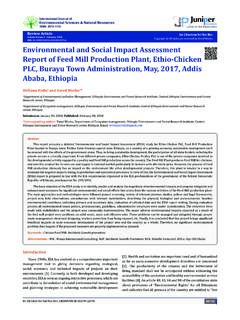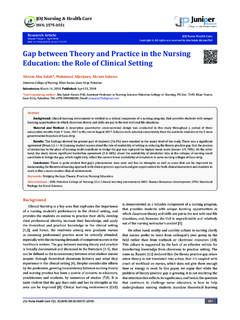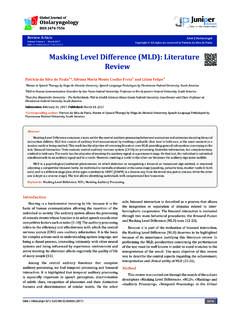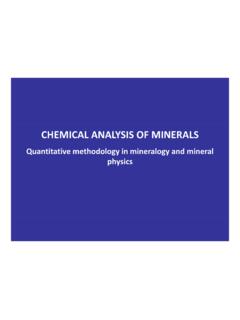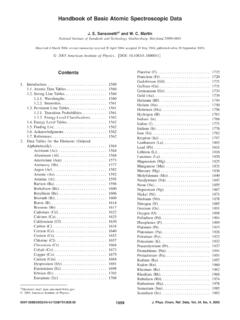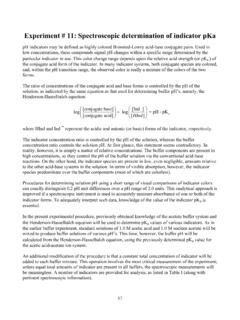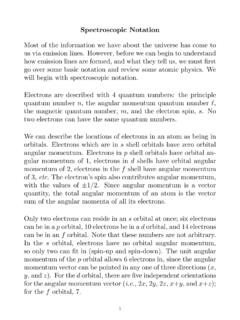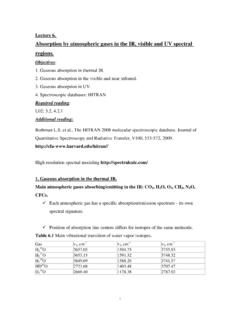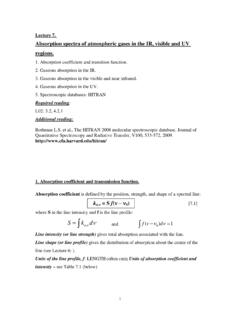Transcription of UV Spectroscopic Method for Determination of Vitamin C ...
1 Int J Environ Sci Nat Res 21(2): (2019)0041 IntroductionVitamins are organic compound (non-energy producing), which are essential for normal human metabolism that must be supplied in small quantities in the diet. The definition excludes the inorganic essential trace minerals and essential amino acids and fatty acids which are required in much larger quantities. Other substances needed for proper growth of microorganism or cells in culture are called growth factors. The different chemical forms and precursors of Vitamin can be called its vitamers.
2 The vitamins as a drug is necessary in the prevention and treatment of deficiency disease. Some vitamins do have major uses in pharmacological uses in pharmacological doses. Vitamin deficiency occur due to inadequate intake, malabsorption, increased tissue needs, increased excretion, certain genetic abnormalities and drug Vitamin interaction. Vitamin C is a major water-soluble antioxidant. Generally, Vitamin C is 6 carbon organic acid with structural similarity to glucose. It acts as a potent reducing agent and its l form is generally more active.
3 Citrus fruits are rich sources of Vitamin C. According to recent research human milk contains more amount of Vitamin C than the cow s milk. It is mostly absorbed from and widely distributed extra and intra muscularly. Plasma concentration and total body store of Vitamin c depends upon daily intake of ascorbic acid content food. The usual 60mg/day intake results in about in plasma and in the body as a whole. Increasing proportion are excreted in urine with higher intake. Body is not able to store more than It is partly oxidised to active (dehydroascorbic acid) and inactive (oxalic acid) metabolites.
4 The therapeutic uses of ascorbic acid include prevention of ascorbic acid deficiency in patient at a risk and in infants, treatment of scurvy, in anaemia, to acidify the urine in urinary tract infection. They lower blood pressure and cholesterol level in the body. Also reduces the cold and has beneficial effect in the bacterial infection. Adequate amount of Vitamin c intake may also prevent developing cancer of breast, cervix, colon get Vitamin C from the food particularly fruit and vegetables. Our bodies need Vitamin C to make a substance collagen which is important for the health and repair of our skin, bones, teeth and cartilage.
5 Vitamin C was first isolated in 1928. In 1932 it was proved to be the agent, which prevents scurvy. Scurvy is a diseased condition which occurs due to deficiency of Vitamin C in the body. The common sources of Vitamin C are citrus fruits and some other foods like tomatoes, broccoli, cauliflower, spinach, ladyfinger etc. The development of rapid, simple, and inexpensive analytical methods is one of areas of growing interest, especially since quick decisions are needed in environmental, medical, and industrial fields. Many analytical methods were used for ascorbic acid Determination , including Titrimetric spectrophotometry and Chromatography, titrimetric, voltammetry, fluorometry, potentiometry as an analytical technique.
6 Similarly, liquid chromatography capillary electrophoresis and gas chromatography were also used for the AbstractIn the present study, Determination of ascorbic acid content is determined in different fruits by using UV spectroscopy. In this Method bromine water is added which oxidizes the ascorbic acid into dehydroascorbic acid. 2,4 dinitrophenyl hydrazine gives coupling reaction at 37 C temperature for 3 hours. After 3 hours solution is treated with 85% H2SO4 which gives coloured complex and the absorbance was measured at 491nm. The content of Vitamin C was found maximum in Black currant and minimum in : UV spectrophotometer; South Gujarat region; Ascorbic acid; FruitsUV Spectroscopic Method for Determination of Vitamin C (Ascorbic Acid) Content in Different Fruits in South Gujarat RegionResearch ArticleVolume 21 Issue 2 - August 2019 DOI: J Environ Sci Nat ResCopyright All rights are reserved by Anal DesaiAnal Parimal Desai* and Shuchi DesaiDepartment of Pharmaceutical Quality Assurance, ROFEL Shri G M Bilakhia College of Pharmacy, IndiaSubmission: July 29, 2019.
7 Published: August 21, 2019*Corresponding author: Anal Desai, Department of Pharmaceutical Quality Assurance, ROFEL Shri G M Bilakhia College of Pharmacy, IndiaHow to cite this article: Anal Parimal Desai, Shuchi Desai. UV Spectroscopic Method for Determination of Vitamin C (Ascorbic Acid) Content in Different Fruits in South Gujarat Region. Int J Environ Sci Nat Res. 2019; 21(1): 556055. DOI: Journal of Environmental Sciences & Natural Resourcesdetermination of ascorbic acid from different species of citrus fruits. UV Spectrophotometry is mostly used to determine ascorbic acid because it is simple Method , and Vitamin C is able to absorb UV rays.
8 The Method is suitable for use with Vitamin C tablets, fresh or packaged fruit juices and solid fruits and ,4 DNPH Method of determining ascorbic acid content involves coupling reaction. This Method is used in determining ascorbic acid content in different fruits and vegetables. 2,4 DNPH act as a dye in this Method . In this Method the total amount of Vitamin C (Ascorbic acid + Dehydroascorbic acid) is determined in fruits by using UV spectrophotometer. Here bromine water is used which oxidizes the ascorbic acid into dehydroascorbic acid in the presence of acetic acid.
9 Then known amount of 2,4 DNPH is added which gives coupling reaction. Solutions are kept for 3 hours. After 3 hours 85% H2SO4 is added which gives coloured solution. These solutions are then measured for determining ascorbic acid content by using UV and MethodsMaterials: 5% Metaphosphoric acid-10% acetic acid, 10% Thiourea solution, 2,4-Dinitrophenylhydrazine solution, 85% Sulphuric acidInstrumenti. UV- Visible spectrophotometer (Double beam) having matched quartz cells of light path Model: Shimadzu 1800 iii. Software: UV probe Version of software: iv. Electronic analytical weighing balance (REPTECH)v.
10 Volumetric flask (Borosilicate),vi. Pipettes,vii. Conical gooseberries, mulberry, karanda, black current, grapes, mango, guava, wax apple, muskmelon, watermelon, pomegranate, lemon (sweet lemon). Standard ascorbic acid solutionStandard ascorbic acid solution was prepared by dissolving 50mg of AA in 100ml of distilled water. (500 g/ml)Preparation of calibration curveCalibration curve of different concentration 5,10,15,20,25 g/ml was prepared by proper dilution extract preparationSample extract is prepared by blending 10g of sample in the blender.
